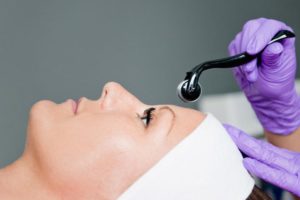What is a chemical peel?

A chemical peel is a form of cosmetic treatment used to improve the appearance of one’s skin, whether that be making someone look younger by decreasing dark spots and pigmentation, or evening the skin tone. Chemical peels are available in concentrations that vary in order to best meet the needs of the person getting the peel.
How long has it been around?
Various forms of chemical peels have been utilized for centuries, dating back to the Ancient Egyptians, but it really took off in the late 1800’s when Viennese dermatologist Ferdinand Hebra pioneered the treatment for it’s therapeutic benefits. Hebra began repetitive treatment of freckles and melasma with various chemicals and exfoliants to lighten the skin and decrease pigmentation. In 1882, German dermatologist, P.G. Unna described the properties of salicylic acid, resorcinol, phenol, and trichloroacetic acid (TCA). These works were foundational for treatments that would eventually utilize beta-hydroxy acid, salicylic acid, resorcinol, and TCA, while also setting the tone for European peeling experiences that would be largely popularized at the start of the 20th century. Chemical peels made its way to America in 1903, when British dermatologist George Miller Mackie became chairman of the dermatology department at New York University and began using phenol to treat acne scarring. As a result, in the 1940’s phenol treatments became the treatment of choice and was regularly used for acne scars for its obvious overall improvements in one’s skin. His work was published in 1952 and the publication was the first time a correlation between chemical peeling and clinical results was shown.
How does it work?
Before getting a chemical peel, it is important to determine if a person is a good candidate for the treatment. Factors include age, skin type, medical history, current medications, and realistic expectations. A chemical peel takes less than 30 minutes and works by dissolving the outermost layer of the skin (epidermis) to reveal a brighter, younger looking, healthier complexion. The patient will be instructed to lay down so that the doctor may begin prepping and cleaning their skin. Afterwards, the chemical peel will be applied and the patient may notice redness, burning, or a stinging sensation. Once the peel has been applied, the patient will notice some tightness. Over the next several days, the patient will begin to shed where the chemical peel was applied and will be instructed to avoid direct sunlight/ UV light, wear sunscreen, and gently cleanse the skin. The face or area where the chemical peel was applied will continue to peel in patches but it is important to avoid picking at it or scratching the skin. After the skin has completely peeled, a person should notice a refreshed, brighter, and smoother complexion, but results vary based on age, skin type, and other important factors.
What are the side effects?
Side effects most commonly associated with chemical peels include redness that may last several days or weeks, changes in skin color (hyperpigmentation / hypopigmentation), and a herpes flare up for those that have the herpes simplex virus. Additional side effects may include infection and scarring or skin damage.
What are the advantages?

Chemical peels may be done to the face, neck, hands, and back to improve the skin’s overall appearance and reveal brighter, more youthful skin. Additional benefits include a decrease in wrinkles and fine lines, treatment of uneven skin and acne, improvement in the appearance of mild scars, while also making your skin more receptive to your regular skin care routine. Furthermore, chemical peels have a low risk and are customizable to fit the skincare needs of each and every individual..
How long does it take for it to work?
Results vary on multiple factors (age, skin type, problem areas, patient outcome goals and expectations), but many patients may notice a subtle difference immediately after the peel. Several days after the initial treatment, the area will peel and a new, youthful layer of skin will be revealed. Patients may repeat the peel every one to four weeks depending on the results they are trying to achieve.
Who can benefit from it?
Chemical peels are often used by those with a fairer complexion. Those with darker skin may also benefit from the chemical, but they have an increased risk of hyperpigmentation and an uneven skin tone. Individuals with acne, wrinkles, dull skin, sun damage, and melasma may also benefit from a chemical peel.
Patients will excessively sensitive skin, a history of accutane use within the last year, history of vitiligo, or aspirin allergy should avoid chemical peels.
What are the post op treatments?
After a chemical peel, a patient may experience a reaction similar to that of a sunburn, and it is important that they take good care of their skin for optimal results and to prevent undesirable outcomes. Post-op care includes avoiding exposure to direct sunlight and UV rays, which will mean staying indoors, wearing sunscreen, and keeping an umbrella or wide-brimmed hat handy to protect one’s face from the sun. Additionally, patients should use a gentle, soap-free cleanser to cleanse their skin. Most importantly, do not pick at the peeling skin!
